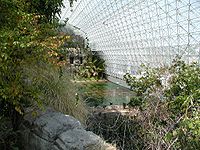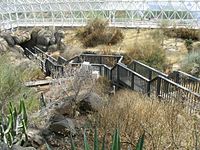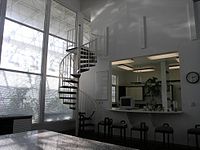Biosphere 2
- Ayrıntılar
- Üst Kategori: ROOT
- Kategori: Ecological Design
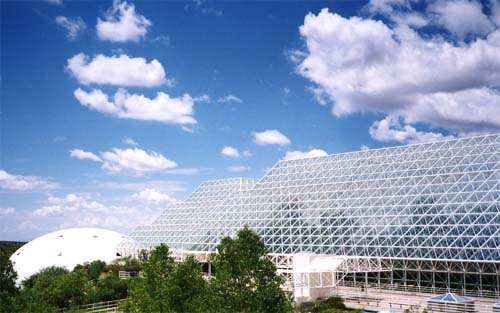
Biosphere 2 is a 3.15-acre (12,700 m2)[1] structure originally built to be an artificial, materially-closed ecological system in Oracle, Arizona (USA) by Space Biosphere Ventures, a joint venture whose principal officers were John P. Allen, inventor and Executive Director, and Margret Augustine, CEO. Constructed between 1987 and 1991, it was used to explore the complex web of interactions within life systems in a structure that included five areas based on natural biomes and an agricultural area and human living/working space to study the interactions between humans, farming and technology with the rest of nature.[2] It also explored the possible use of closed biospheres in space colonization, and allowed the study and manipulation of a biosphere without harming Earth's. The name comes from Earth’s biosphere, Biosphere 1, Earth's life system and the only biosphere currently known. Funding for the project came primarily from the joint venture’s financial partner, Ed Bass' Decisions Investment, and cost $200 million from 1985 to 2007, including land, support research greenhouses, test module and staff facilities.
Contents |
Biosphere 2
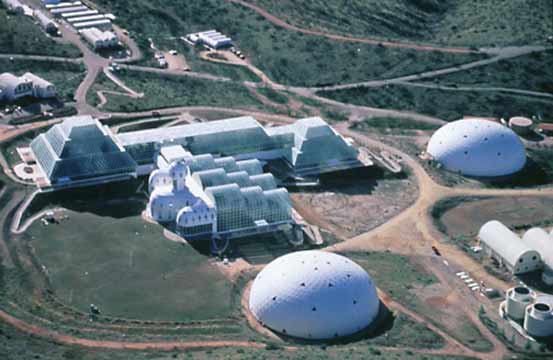 At a size comparable to two and a half football fields, it remains the largest closed system ever created. The glass facility is elevated nearly 4,000 feet above sea level at the base of the Santa Catalina Mountains. [3] The sealed nature of the structure allowed scientists to monitor the continually changing chemistry of the air, water and soil contained within. Health of the human crew was monitored by a medical doctor inside and an outside medical team.
At a size comparable to two and a half football fields, it remains the largest closed system ever created. The glass facility is elevated nearly 4,000 feet above sea level at the base of the Santa Catalina Mountains. [3] The sealed nature of the structure allowed scientists to monitor the continually changing chemistry of the air, water and soil contained within. Health of the human crew was monitored by a medical doctor inside and an outside medical team.
Biosphere 2 contained representative biomes: a 1,900 square meter rainforest, an 850 square meter ocean with a coral reef, a 450 square meter mangrove wetlands, a 1,300 square meter savannah grassland, a 1,400 square meter fog desert, a 2,500 square meter agricultural system, a human habitat, and a below-ground level technical infrastructure. Heating and cooling water circulated through independent piping systems and passive solar input through the glass space frame panels covering most of the facility, and electrical power was supplied into Biosphere 2 from an onsite natural gas energy center through airtight penetrations.
Biosphere 2 had two closure experiments, Missions 1 and 2. The first, with a crew of eight people, ran for two years 1991-93. Following a six month transition period during which researchers entered the facility through airlock doors and conducted research and system engineering improvements, a second closure with a crew of seven people was conducted March 1994-September 1994. In the course of that second mission, a dispute over management of the financial aspects of the project caused the on-site management to be locked out, and the mission itself to be ended prematurely.
In 1995, Columbia University took over management of the facility for research and as a campus until 2003. In 1996, they changed the virtually airtight, materially-closed structure designed for closed system research, to a “flow-through” system, and halted closed system research. They manipulated carbon dioxide levels for global warming research, and injected desired amounts of carbon dioxide, venting as needed.[4]
By 2006, the property, which is in exurban Tucson, was slated to be redeveloped for a planned community.[5] As of June 5, 2007, the property including surrounding land, totaling 1,650 acres (6.7 km2), had been sold to a residential home developer for US$50 million. A development including homes and a resort hotel was planned for a portion of the land. The Biosphere itself remains open for tours.[6]
On June 26, 2007, the University of Arizona announced it would take over research at the Biosphere 2. The announcement ended immediate fears that the famous glass vivarium would be demolished. University officials said private gifts and grants enabled them to cover research and operating costs for three years with the possibility of extending that funding for 10 years.[7]. It has in fact been extended for ten years, and is engaged in multi-year research projects including research into the water use of various Arizona grass species.
History
Pilot experiments
Prior to closure of Biosphere 2, initial tests were carried out in a smaller, 480 cubic meter onsite facility (the "Test Module"), looking at potable water generation, atmospheric sealing, atmospheric expansion and contraction, and the behavior of life systems inside a closed ecological system. Three closures with one human inhabitant were carried out. This allowed advance modeling of Biosphere 2’s ability to maintain carbon dioxide at acceptable levels.[8] The notable precedent to this closed life system research had been conducted in the 1970s by the Soviet team at Bios 3.
Sue Allen spent three days in the Test Module, then Abigail Alling spent five days, then finally Linda Leigh stayed three weeks. They recycled water including human waste, maintained a healthy atmosphere and tended a small agricultural area. These experiments were too short to attempt long-term agriculture or animal husbandry. Greenhouses at the site and Environmental Research Laboratory of the University of Arizona tested potential food cultivars and allowed the crew ("biospherians") in training to practice growing the full range of crops and raise domestic animals (chickens, goats, pigs).[9]
The agricultural area of Biosphere 2 was planted over a year before closure, and biospherians managed their farm, growing and processing food, so that there would be a supply of food grown inside when the full closure began. During week-long periods of simulated full closure, data was gathered on agricultural operations and productivity, and crew adapted to their workload.
These mini-missions were, of course, far too short to attempt any meaningful agriculture or animal husbandry. No data was gathered that might have been useful in estimating whether the Biosphere itself was capable of sustaining eight people for two years.
First mission
The first closed mission lasted from September 26, 1991 to September 26, 1993. The crew were: medical doctor and researcher Roy Walford, Jane Poynter, Taber MacCallum, Mark Nelson, Sally Silverstone, Abigail Alling (a late replacement for Silke Schneider), Mark Van Thillo and Linda Leigh.
The agricultural system produced 83% of the total diet, which included a wide variety of crops including bananas, papayas, sweet potatoes, beets, peanuts, lablab and cowpea beans, rice, and wheat.[10] No toxic chemicals could be used, since they would quickly impact health. During the first year the eight inhabitants experienced hunger as they adapted. During the second year, the crew produced over a ton more food, average caloric intake increased, and they regained some weight lost during the first year.
They consumed the same low-calorie, nutrient-dense diet which Roy Walford had extensively studied in his research on extending lifespan through diet. Medical markers indicated the health of the crew during the two years was excellent. Strikingly, they showed the same improvement in health indices such as lowering of blood cholesterol, blood pressure, enhancement of immune system. They lost an average of 16% of their pre-entry body weight before stabilizing and regaining some weight during their second year.[11]Subsequent studies showed that the biospherians’ metabolism became more efficient at extracting nutrients from their food as an adaptation to the low-calorie, high nutrient diet.[12]
Some of the domestic animals that were planned for the agricultural area during the first mission include four pygmy goats and one billy goat from the plateau region of Nigeria, 35 hens and three roosters (a mix of Indian jungle fowl or gallus gallus, Japanese silky bantam, and a hybrid of these), two sows and one boar pig (feral), as well as tilapia fish grown in a rice and azolla pond system originating millennia ago in China.[13]
A strategy of “species-packing” was practiced to ensure that food webs and ecological function could be maintained if some species did not survive. The fog desert area became more chaparral due to condensation from the space frame. The savannah was seasonally active; its biomass was cut and stored by the crew as part of their management of carbon dioxide. Rainforest pioneer species grew rapidly, but trees there and in the savannah suffered from etiolation and weakness caused by lack of stress wood, normally created in response to winds in natural conditions. Corals reproduced in the ocean area and crew helped maintain ocean system health by hand-harvesting algae from the corals, manipulating calcium carbonate and pH levels to prevent the ocean becoming too acidic, and by installing an improved protein skimmer to supplement the algae turf scrubber system originally installed to remove excess nutrients.[14] The mangrove area developed rapidly but with less understory than a typical wetland possibly because of reduced light levels.[15]
Biosphere 2 suffered from CO2 levels that "fluctuated wildly" and most of the vertebrate species and all of the pollinating insects died.[16] Insect pests, like cockroaches, boomed. In practice, ants, a companion to one of the tree species (Cecropia) in the Rain Forest, had been introduced. By 1993 the tramp ant species paratrechina longicornis, local to the area had been unintentionally sealed in and had come to dominate. Galagos reproduced in Biosphere 2, but a number of pollinating insects were lost to ant predation and several bird species were lost. However many of the pollinating duties were performed by those ants and cockroaches.
Oxygen
During the first mission, the oxygen inside the facility, which began at 20.9%, fell at a steady pace and after 16 months was down to 14.5%. This is equivalent to the oxygen availability at an elevation of 4,080 meters (13,400 ft).[17] Since some biospherians were starting to have symptoms like sleep apnea and fatigue, Walford and the medical team decided to boost oxygen with injections in January and August 1993.
Daily fluctuation of carbon dioxide dynamics was typically 600 ppm because of the strong drawdown during sunlight hours by plant photosynthesis, followed by a similar rise during the nighttime when system respiration dominated. As expected, there was also a strong seasonal signature to CO2 levels, with wintertime levels as high as 4,000-4,500 and summertime levels near 1,000 ppm. The crew worked to manage the CO2 by occasionally turning on a CO2 scrubber, activating and de-activating the desert and savannah through control of irrigation water, cutting and storing biomass to sequester carbon, and utilizing all potential planting areas with fast-growing species to increase system photosynthesis.[18]
Many suspected the drop in oxygen was due to microbes in the soil. The soils were selected to have enough carbon to provide for the plants of the ecosystems to grow from infancy to maturity, a plant mass increase of perhaps 20 tons (18,000 kg).[19] The release rate of that soil carbon as carbon dioxide by respiration of soil microbes was an unknown that the Biosphere 2 experiment was designed to reveal. El Nino weather systems blocked necessary sunlight resulting in lower oxygen production.
The respiration rate was faster than the photosynthesis (possibly in part due to relatively low light penetration through the glazed structure) resulting in a slow decrease of oxygen. A mystery accompanied the oxygen decline: the corresponding increase in carbon dioxide did not appear. This concealed the underlying process until an investigation by Jeff Severinghaus and Wallace Broecker of Columbia University’s Lamont Doherty Earth Observatory using isotopic analysis showed that carbon dioxide was reacting with exposed concrete inside Biosphere 2 to form calcium carbonate, thereby sequestering the carbon dioxide and, as part of it, the oxygen that had disappeared.[20]
The discovery of the small difference between rate of respiration and rate of photosynthesis depended on the extremely low leak rate of Biosphere 2. It was shown by Dempster that had Biosphere 2 leaked as much as other closed ecological test chambers, the wash-out effect of outside air mixing in would have concealed the entire imbalance.
Second mission
During the transition period between missions, extensive research and system improvements had been undertaken. Concrete was sealed to prevent uptake of carbon dioxide. The second mission began on March 6, 1994, with an announced run of ten months. Crew was Norberto Romo (Capt.), John Druitt, Matt Finn, Pascale Maslin, Charlotte Godfrey, Rodrigo Romo and Tilak Mahato. The second crew achieved complete sufficiency in food production.[21]
On April 1, 1994 a severe dispute[22] within the management team led to the ousting of the on-site management by federal marshals serving a restraining order,[23] leaving management of the mission to Ed Bass' company Decisions Investment.
At 3 am on April 5, 1994, Abigail Alling and Mark Van Thillo, members of the first crew, deliberately vandalized the project from outside, opening a door and violating the closure.[24]
Soon after that, the captain Norberto Romo (by then married to Margret Augustine) left the Biosphere. He was replaced by Bernd Zabel, who had been nominated as captain of the first mission but replaced at the last minute. Two months later, Matt Smith replaced Matt Finn.
The ownership and management company Space Biospheres Ventures was officially dissolved on June 1, 1994, leaving scientific and business management of the mission to the financial partner, Decisions Investment.
Mission 2 was ended prematurely on September 6, 1994.
Columbia University
In 1995 the Biosphere 2 owners transferred management to Columbia University.[25] Columbia ran Biosphere 2 as a research site and campus until 2003,[26] at which time management reverted to the owners. During Columbia's tenure, Columbia students would often spend one semester at the site.
Site sold
On January 10, 2005 Decisions Investments Corporation, owner of Biosphere 2, announced that the Biosphere 2 campus was for sale. They preferred a research use to be found for the complex but were not excluding buyers with different intentions, such as universities, hotels, resorts, spas, etc. In June, 2007 Associated Press announced a $50 million sale to CDO Ranching & Development, L.P.[27] 1,500 houses and a resort hotel are planned, but the main structure is still to be available for research and educational use.
Under new management
On June 26, 2007, the University of Arizona announced that it took over management of Biosphere 2, using the site as a laboratory to study climate change, among other things.
Engineering
The structure was notable for how it dealt with atmospheric expansion. During the day, the heat from the sun caused the air inside to expand and during the night it cooled and contracted. To avoid having to deal with the huge forces that maintaining a constant volume would create, the structure had large diaphragms kept in domes called "lungs".
Since opening a window was impossible, the structure also required huge air conditioners to control the temperature and avoid killing the plants within. For every unit of solar energy that entered the structure, the air conditioners would expend approximately three times as much energy to cool the habitat back down.
Science
A special issue of the Ecological Engineering journal edited by B.D.V. Marino and Howard T. Odum (1999), published as "Biosphere 2: Research Past and Present" (Elsevier, 1999) represents the most comprehensive assemblage of collected papers and findings from Biosphere 2. The papers range from calibrated models that describe the system metabolism, hydrologic balance, and heat and humidity, to papers that describe rainforest, mangrove, ocean, and agronomic system development in this carbon dioxide-rich environment.[28][29]
Criticism
One view of Biosphere 2 was that it was "the most exciting scientific project to be undertaken in the U.S. since President John F. Kennedy launched us toward the moon".[30] Others called it "New Age drivel masquerading as science".[31] The Institute for Ecotechnics, which awarded Margret Augustine and other Biospherians their "science credentials", was shown by a CBC documentary to be nothing more than an art gallery and café in London.[32] John Allen did have mainstream credentials: a degree in Metallurgical-Mining Engineering from the Colorado School of Mines, and an MBA from the Harvard Business School.[13][33]
Further damaging the credentials of the participants, Marc Cooper wrote[34] that "the group that built, conceived, and directs the Biosphere project is not a group of high-tech researchers on the cutting edge of science but a clique of recycled theater performers that evolved out of an authoritarian – and decidedly non-scientific – personality cult". He was referring to the Synergia Ranch in New Mexico, an outpost of the Institute of Ecotechnics where indeed many of the Biospherians did practice improv theater under John Allen's leadership, and began to develop the ideas behind Biosphere 2.[35]
One of their own scientific consultants came to be critical of the enterprise, too. Dr. Ghillean Prance, director of the Royal Botanical Gardens in Kew, designed the rainforest biome inside the Biosphere. In a 1983 interview, Prance said, "I was attracted to the Institute of Ecotechnics because funds for research were being cut and the institute seemed to have a lot of money which it was willing to spend freely. Along with others, I was ill-used. Their interest in science is not genuine. They seem to have some sort of secret agenda, they seem to be guided by some sort of religious or philosophical system."[36]
[edit] Psychology and conflict
Much of the evidence for isolated human groups comes from psychological studies of scientists overwintering in Antarctic research stations.[37] The study of this phenomenon is "confined environment psychology", and according to Jane Poynter[38][39] not nearly enough of it was brought to bear on Biosphere 2.
Before the first closure mission was half over, the group had split into two factions and people who had been intimate friends had become implacable enemies, barely on speaking terms.
The faction inside the bubble came from a rift between the joint venture partners on how the science should proceed, as biospherics or as specialist ecosystem studies. Was the Biosphere a scientific experiment or a business venture? Or perhaps just an enormous art installation? The faction that included Poynter felt strongly that they should be making formal proposals for research for the Science Advisory Committee to evaluate. The other faction included Abigail Alling, the titular director of research[40] inside the bubble, and who sided with John Allen in blocking that move. On February 14, the entire SAC resigned.[41] Time Magazine wrote:
Now, the veneer of credibility, already bruised by allegations of tamper-prone data, secret food caches and smuggled supplies, has cracked ... the two-year experiment in self-sufficiency is starting to look less like science and more like a $150 million stunt.[42]
Undoubtedly the lack of oxygen and the calorie restricted nutrient dense diet[43] contributed to low morale. The Alling faction feared that the Poynter group were prepared to go so far as to import food, if it meant making them fitter to carry out research projects. They considered that would be a project failure by definition.
The external management could certainly have done more to defuse the intolerable situation inside. Instead they provoked the Poynter faction further by putting Sally Silverstone in charge of day-to-day agricultural operations, replacing Poynter.
In November the hungry Biospherians began eating emergency food supplies that had not been grown inside the bubble.[44] Poynter made Chris Helms, PR Director for the enterprise, aware of this. She was promptly dismissed by Margret Augustine, CEO of Space Biospheres Ventures, and told to come out of the biosphere. This order was, however, never carried out.
Results
As with all experiments, whether considered successes or failures, the results have proved informative; in the case of Biosphere 2, the experimenters learned that small, closed ecosystems are complex and vulnerable to unplanned events. This lesson will almost certainly be applicable in the more hazardous environment of space.
In a strictly business evaluation, Biosphere 2 has to be judged a failure of management. There was never any consideration that the project could be profitable, but it had the means of defraying some of its vast expense given that 20,000 visitors a month were paying up to US$80 for the tour at one time (the current adult tour is $20 with substantial discounts for students, seniors, and children).[45]Edward Bass quite evidently believed that the management could be improved.
See also
- BIOS-3 a closed ecosystem at the Institute of Biophysics in Krasnoyarsk, Siberia, in what was then the Soviet Union.
- Eden Project
- John P. Allen, inventor and Executive Director of Biosphere 2
- Jane Poynter, crewmember of first Biosphere 2 enclosure.
- Taber MacCallum, the Biosphere 2 team's analytical chemist.
- Roy Walford bionaut and anti-aging researcher.
In popular culture
- Film
- The film Bio-Dome (1996) is a parody of Biosphere 2. The exterior shots were filmed on location at the Donald C. Tillman Water Reclamation Plant in Van Nuys, California, and the Valencia High School, in Valencia, California, USA.[46]
- Music
- The song "Old Black Dawning" by Frank Black is about Biosphere 2.
- Musician Geir Jenssen records under the name "Biosphere", after the Biosphere project.[47]
- Television
- Cheers episode #251, originally broadcast November 12, 1992, features Lillith Sternan-Crane deciding to spend a year in "the ecopod", a parody of the Biosphere.
- In an episode of Seinfeld, George lies and says that Elaine has been chosen to represent the Upper West Side in the next biosphere project. In another episode, Jerry says about a giant can of tuna, "This isn't for a person, this is for Biosphere 3!"
- In an episode of Johnny Bravo, four scientists, including Johnny's friend Carl tried to survive for one year in the Biosphere. However, Johnny got in as well, and ruins all the resources.
- In episode 56 of the Nickelodeon series Hey Arnold!, "Bio Square", Arnold and Helga spend a weekend locked in his grandfather's greenhouse, for a school science project similar in concept to Biosphere 2.
- Video games
- The PC adventure and puzzle game Biosys (1999) takes place in four different biodomes which simulate 'rainforest', 'savanna', 'ocean', and 'accelerated evolution'. Much of the game revolves around manipulating different environments and discovering the protagonist's own history and involvement with the facility.
- Creatures 3 (1999), a computer game centered on artificial life, took place on a spaceship with several terrariums including a temperate terrarium, jungle terrarium, and desert terrarium.
References
- Notes
- ^ Biosphere 2 - Where science lives
- ^ ”Using a closed ecological system to study Earth’s biosphere: Initial results from Biosphere 2." Bioscience 43(4): 225-236
- ^ Specials
- ^ Marino, B.D.V., and H.T. Odum, Biosphere 2, Introduction and research progress, Ecological Engineering, 13, 3-14, 1999
- ^ Nintzel, Jim (2006-02-16). "Bio Bust". Tucson Weekly. http://www.tucsonweekly.com/gbase/Tools/PrintFriendly?url=%2Fgbase%2FCurrents%2FContent%3Foid%3Doid%253A78666.
- ^ "Biosphere 2 bubble sold to developers". MSNBC. 2007-06-05. http://www.msnbc.msn.com/id/19055888.
- ^ Ryman, Anne (2007-06-26). "UA to take over Biosphere 2 research". The Arizona Republic. http://www.azcentral.com/news/articles/0626biosphere26-ON.html.
- ^ Alling, A., M. Nelson, L. Leigh, R. Frye, N. Alvarez-Romo, T. MacCallum, and J. Allen). 1993. "Experiments on the Closed Ecological System in the Biosphere 2 Test Module." Ecological Microcosms. Springer-Verlag, New York by H.T. Odum and R. Beyers. Pp. 463-479
- ^ Frye. R. and C. Hodges. 1990. Soil Bed Reactor Research of the Environmental Research Laboratory in Support of Research and Development of Biosphere 2. Biological Life Support Technologies: Commercial Opportunities. Synergetic Press/NASA Conf. Publication #3094
- ^ Silverstone, S. and M. Nelson. 1996. “Food Production and Nutrition in Biosphere 2: Results from the First Mission September 1991 to September 1993.” Adv. Space Res. Vol. 18, No. 4/5 pp. 49-61
- ^ Walford, R.L., S.B. Harris, and M.W. Gunion. 1992. Calorically restricted low-fat nutrient-dense diet in Biosphere 2 significantly lowers blood glucose, total leukocyte count, cholesterol, and blood pressure in humans. Proceedings, National Academy of Sciences, USA, V. 89, n. 23: 11533-11537
- ^ Christian Weyer, Roy L Walford, Inge T Harper, Mike Milner, Taber MacCallum, P Antonio Tataranni and Eric Ravussin, Energy metabolism after 2 y of energy restriction: the Biosphere 2 experiment, American Journal of Clinical Nutrition, Vol. 72, No. 4, 946-953, October 2000
- ^ a b Allen, John. Biosphere 2 the human experiment.
- ^ Nelson, M. and W. Dempster. 1996. “Living in Space: Results from Biosphere 2’s Initial Closure, an Early Testbed for Closed Ecological Systems on Mars.” American Astronautical Society: Science & Technology Series. Vol. 86, pp.363-390. AAS 95-488
- ^ Finn, M. 1996. Comparison of mangrove forest structure and function in a mesocosm and Florida. Ph.D. dissertation, Georgetown University, Washington D.C
- ^ college-level textbook Biology by Neil Campbell and Jane Reece
- ^ "BIOSPHERE 2: The Experiment.". http://www.biospherics.org/experimentchrono1.html. Retrieved 2008-01-14.
- ^ Nelson, M, W. F. Dempster, N. Alvarez-Romo, T. MacCallum. 1994, Atmospheric Dynamics and bioregenerative technologies in a soil-based ecological life support system: Initial results from Biosphere 2. Advances in Space Research14 (11):417-426)
- ^ Nelson and Dempster, 1996, op cit.
- ^ Severinghaus, J.P. , W. Broecker, W. Dempster, T. MacCallum, and M. Wahlen. 1994. Oxygen Loss in Biosphere 2. EOS, Transactions of the American Geophysical Union, vol. 75, no. 3, pp. 33, 35-37
- ^ Marino, B.D.V., Mahato, T.R. et al., 1999, The agricultural biome of Biosphere 2: structure, composition and function, Ecological Engineering 13: 199-234
- ^ Auditors acting for Ed Bass had been denied access to the books by Margret Augustine. Bass' people alleged gross financial mis-management of the project,leading to a loss of $25 million in fiscal 1992 --Poynter, pp325-6
- ^ Poynter, pp. 324–6
- ^ "Two Former Biosphere Workers Are Accused of Sabotaging Dome". The New York Times. April 5, 1994. http://www.nytimes.com/1994/04/05/us/two-former-biosphere-workers-are-accused-of-sabotaging-dome.html. Retrieved April 26, 2010.
- ^ Broad, William J. (1996-11-19). "Paradise Lost: Biosphere Retooled as Atmospheric Nightmare". The New York Times. http://query.nytimes.com/gst/fullpage.html?res=9C0CE2D9133AF93AA25752C1A960958260.
- ^ Arenson, Karen W. (2003-09-09). "Columbia University Ends Its Association With Biosphere 2". The New York Times. http://query.nytimes.com/gst/fullpage.html?res=9C02E7D6173BF93AA3575AC0A9659C8B63.
- ^ MSNBC report, June 5 2007
- ^ For a complete list of Biosphere 2 scientific papers and publications see http://biospheres.com/publications.html.
- ^ For research projects and consultants during the first closure experiment: http://biospheres.com/resbio2jntstudy1.html
- ^ Discover, May 1987.
- ^ Ecology, 73(2), 1992, p.713
- ^ Ibid.
- ^ Ibid.
- ^ Cooper, Marc. "Take This Terrarium and Shove It", Village Voice, 1991.
- ^ Poynter, pp. 17–20
- ^ Phoenix New Times, June 19, 1991.
- ^ Science Notes 2000 - Only the Lonely
- ^ Poynter, op. cit.
- ^ YouTube - Biosphere 2 crewmember & author Jane Poynter interview
- ^ Poynter, p. 270
- ^ Poynter, p. 270, quoting Time Magazine.
- ^ "Calorie Restriction in Biosphere 2: Alterations in Physiologic, Hematologic, Hormonal, and Biochemical Parameters in Humans Restricted for a 2-Year Period -- Walford et al. 57 (6): 211 -- Journals of Gerontology Series A: Biological Sciences and Medical Sciences". http://biomed.gerontologyjournals.org/cgi/content/abstract/57/6/B211. "...despite the selective restriction in calories and marked weight loss, all crew members remained in excellent health and sustained a high level of physical and mental activity throughout the entire 2 years."
- ^ Poynter, p. 247.
- ^ Phoenix New Times
- ^ http://www.imdb.com/title/tt0115683/locations
- ^ http://www.biosphere.no/
- Bibliography
- Allen, John P. (2009). Me and the Biospheres: A Memoir by the Inventor of Biosphere 2. Synergetic Press. ISBN 978-0-907791-37-9.
- Marino, B.D.V. and Osum, Howard T. Biosphere 2: Research Past and Present (1999)
- Poynter, Jane (2006). The Human Experiment: Two Years and Twenty Minutes Inside Biosphere 2. Thunder's Mouth Press. ISBN 978-1-56025-775-2.
External links
- Official Website
- Google Maps Satellite view
- Website on biospherics and Biosphere 2
- "Patent for "Pressure balancing a closed ecological system"". U.S. Patent & Trademark Office. http://patft.uspto.gov/netacgi/nph-Parser?patentnumber=5377458. Retrieved December 15, 2005. - Patent for the expanding chambers used to equalize pressure in Biosphere 2.
- Me and the Biospheres website
- Paragon Space Development Corporation, formed with a team of engineers by Biosphere 2 crew-members, while still enclosed.
- Biosphere 2 bubble sold to developers
- Life Under Glass: The Inside Story of Biosphere 2 by Abigail Alling, Mark Nelson and Sally Silverstone, Synergetic Press, 1993
- Biosphere 2 Astronomical Observatory Illustrated history of its founding, operations, closing under Columbia University rule, and disposition with image galleries of its construction in 1999 and removal in 2008.
- Life in Biosphere 2 A talk by Jane Poynter at TED.
- Dreaming the Biosphere by Rebecca Reider, ISBN 978-0826346735
- Sign Posts of Dr. Roy Walford, Voyage of Biosphere 2 by Roy Walford, Chris Rowland






